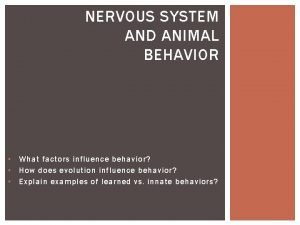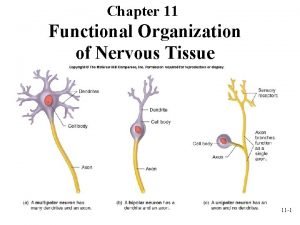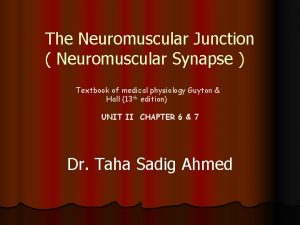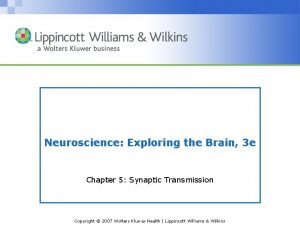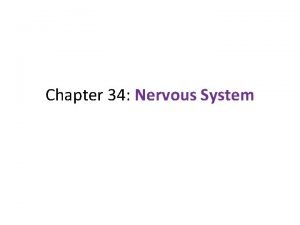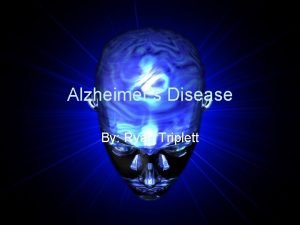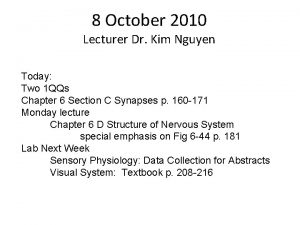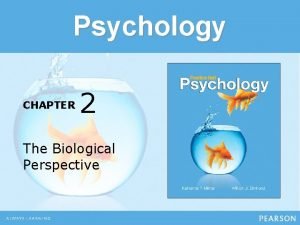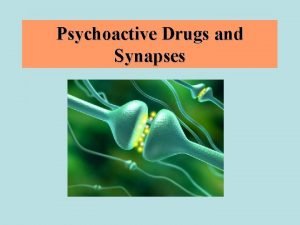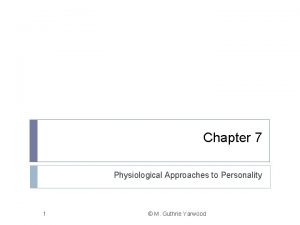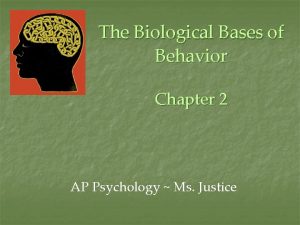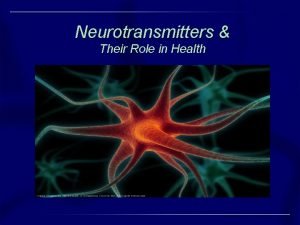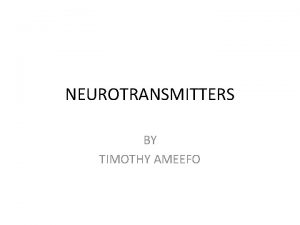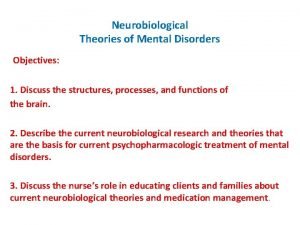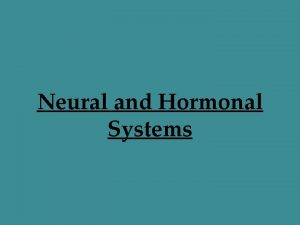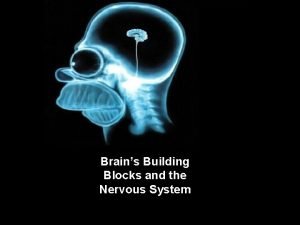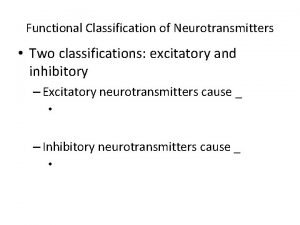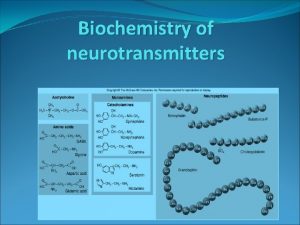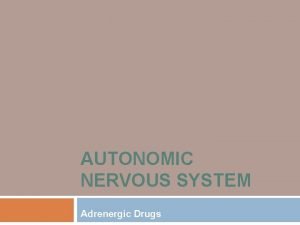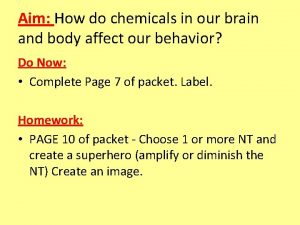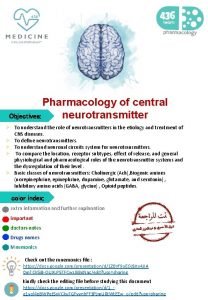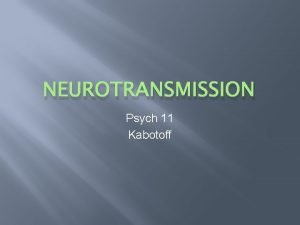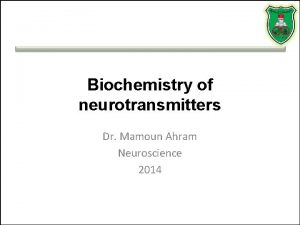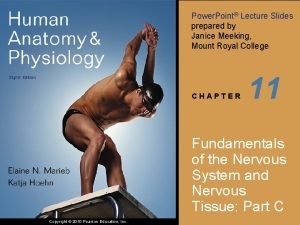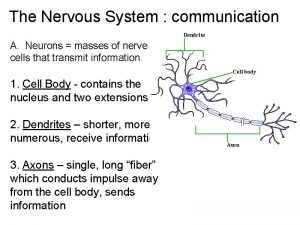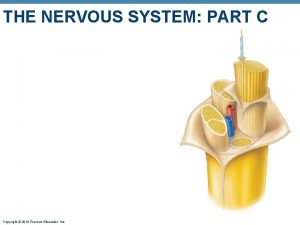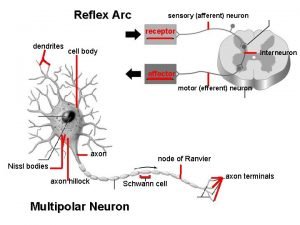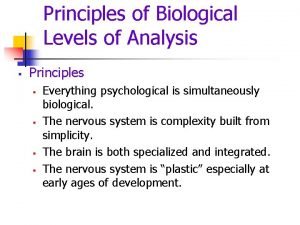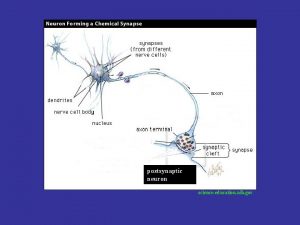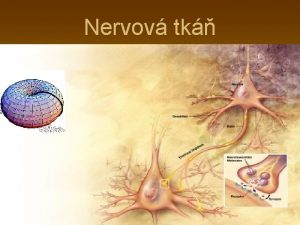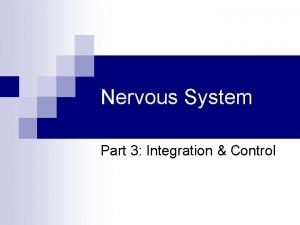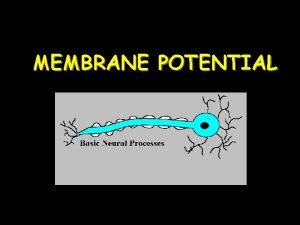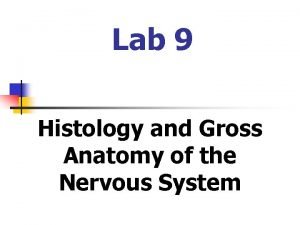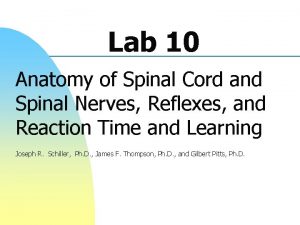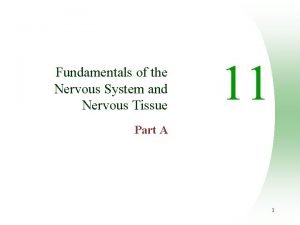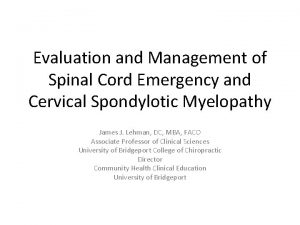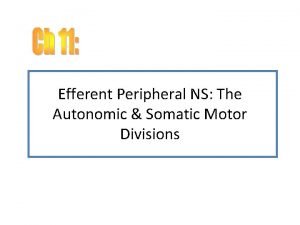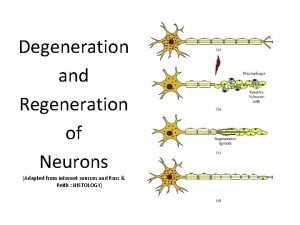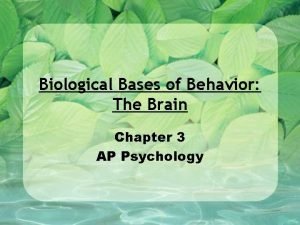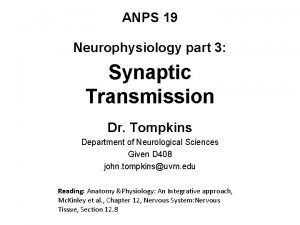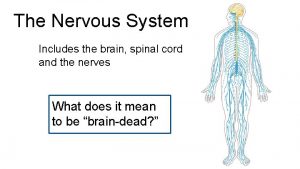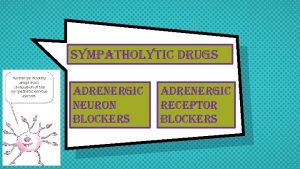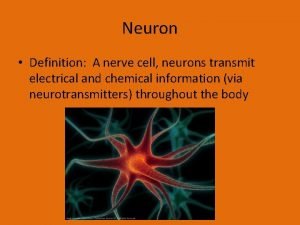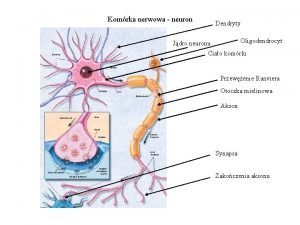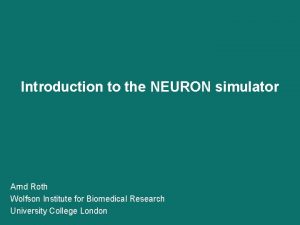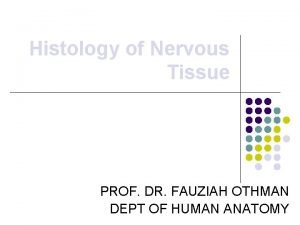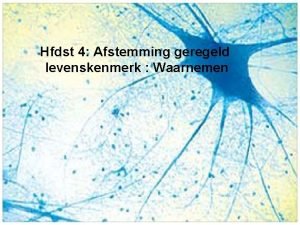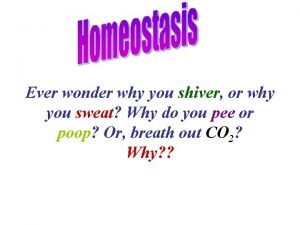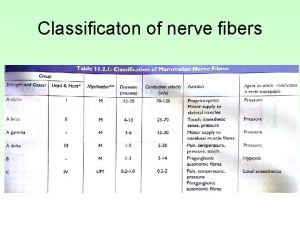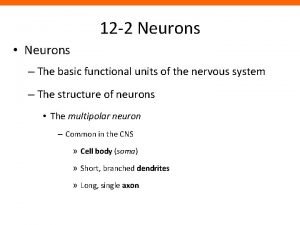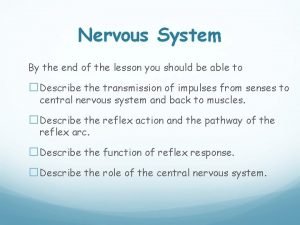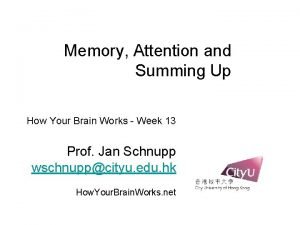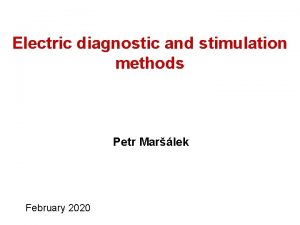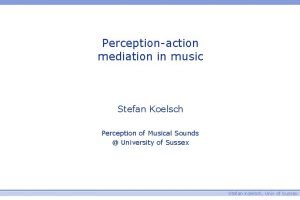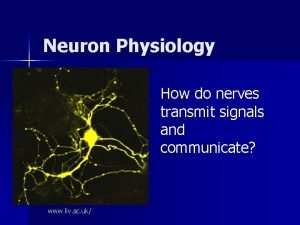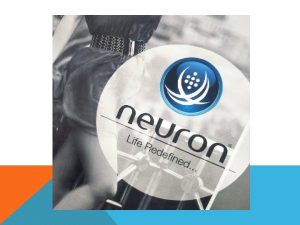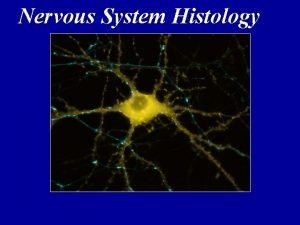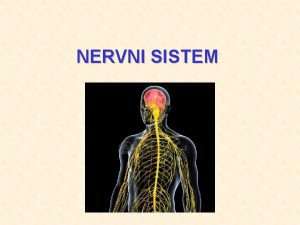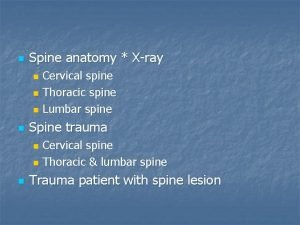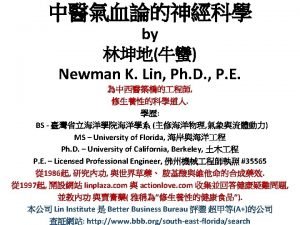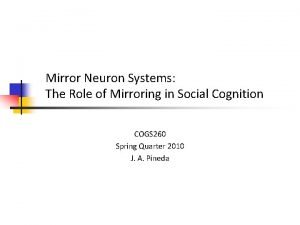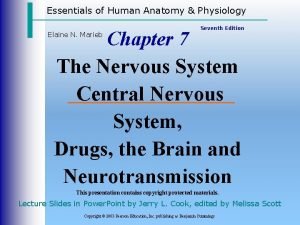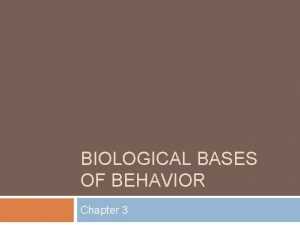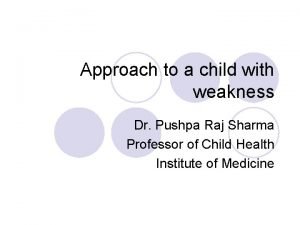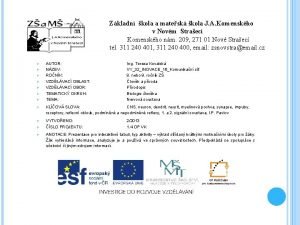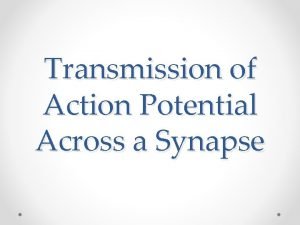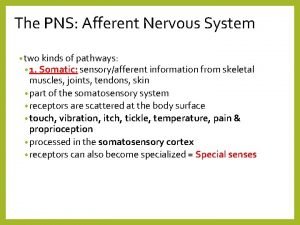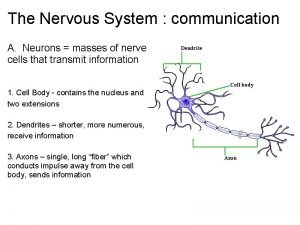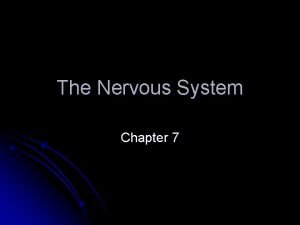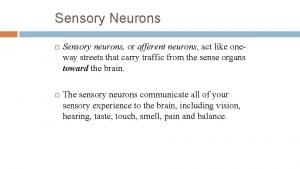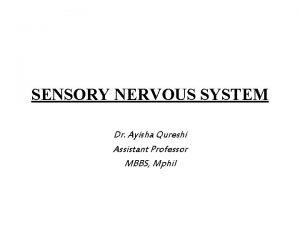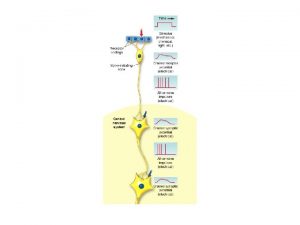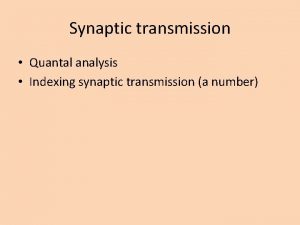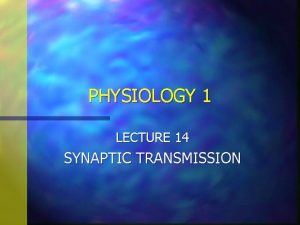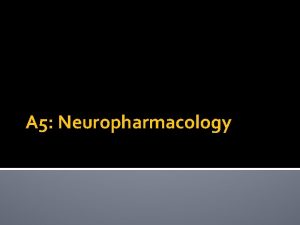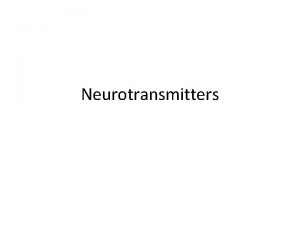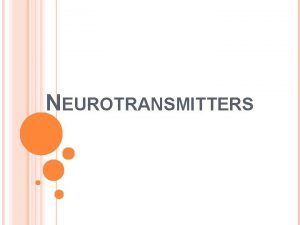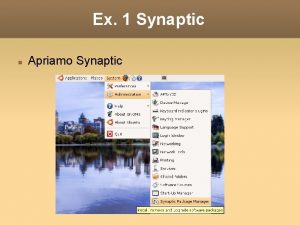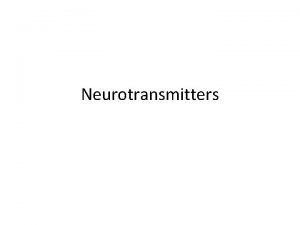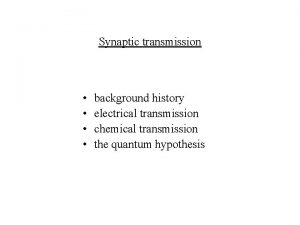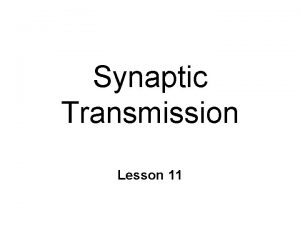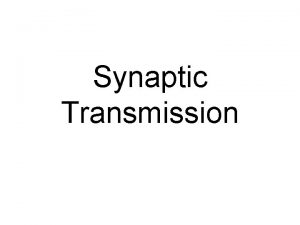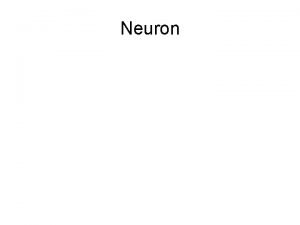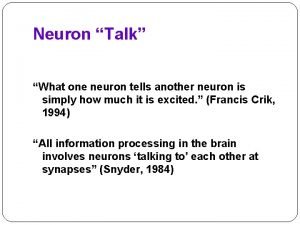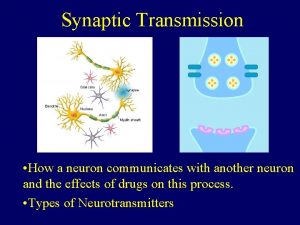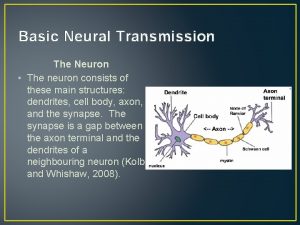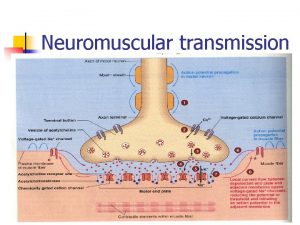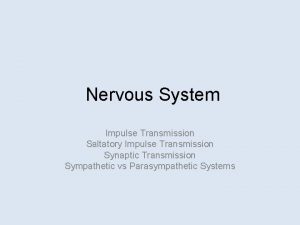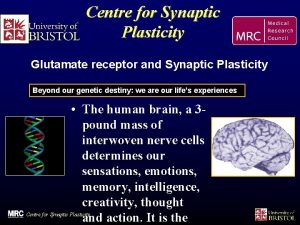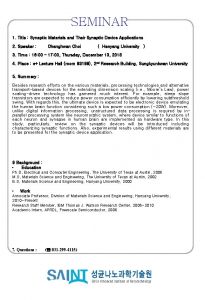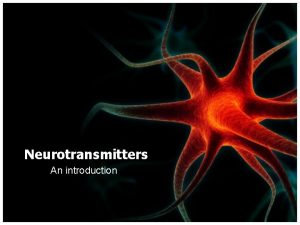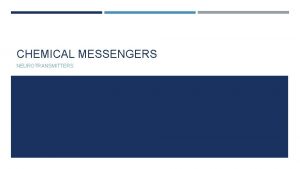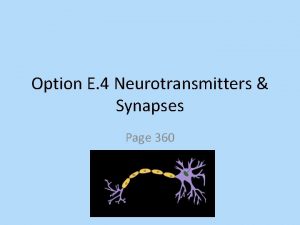CHAPTER 3 The Neuron Synaptic Transmission Neurotransmitters and





































































































- Slides: 101

CHAPTER 3 The Neuron, Synaptic Transmission, Neurotransmitters and the CNS

How do neurons communicate?

a b c


How do neurons communicate? Need to think about this question 2 ways

How do neurons communicate? 1. within neurons – 2. between neurons-

Neuron receiving info Information traveling down neuron

How do neurons communicate � within neurons – electrically � between neurons – chemically ◦ Synapse – space between neurons

Neurons can exist in one of 3 states � the “resting” state � the “active” state � the “refractory” state ◦ neuron is firing ◦ action potential



At rest: � inside of the axon has a slightly negative charge relative to outside the axon ◦ called the membrane potential ◦ usually around -70 m. V

At rest: � inside of the axon has a slightly negative charge relative to outside the axon ◦ called the membrane potential � why?

action potential or spike


Neuron stimulated (either electrically or by receiving a “message” � see depolarization (change from negative inside neuron to more positive)

action potential or spike

Neuron stimulated (either electrically or by receiving a “message” � see depolarization (change from negative inside neuron to more positive) ◦ “threshold” – if a great enough depolarization occurs, an action potential will occur ◦ action potential – very quick – milliseconds �Other terms – spike, firing, generating an AP

action potential or spike

� Hyperpolarization �return to negative �this is the refractory or recovery period

action potential or spike

What causes these changes in electrical potential and the action potential? � All axons and cells have a membrane �thin lipid (fat) bilayer � The membranes have channels (to allow ions in or out) � Ions – molecules with a charge � These channels can be open or shut


What causes these changes in electrical potential? � Ions flowing across the membrane causes the changes in the potential � Ions are molecules that contain a positive or negative charge �anion – negative charge �cation – positive charge

Some important ions for neuronal communication �Na+ sodium ◦ HIGHER CONCENTRATION OUTSIDE THE AXON �Cl- chloride �K+ potassium ◦ HIGHER CONCENTRATION OUTSIDE AXON ◦ higher concentration inside the axon �A- anions -large (-) molecules with a negative charge (stuck inside the axon)

Some forces that play a role in maintaining membrane potential � concentration gradient – ◦ ions diffuse from higher concentration to lower concentration

example of concentration forces

Concentration Gradient Na+ would enter axon K+ K+ would leave axon Cl- would enter axon

Some forces that play a role in maintaining membrane potential � concentration gradient – ◦ ions diffuse from higher concentration to lower concentration � electrical gradient - ◦ opposite charges attract so ions are attracted to an environment that has a charge that is opposite of the charge they carry!

example of electrostatic forces

Electrical Gradient Na+ go in K+ stay in Cl- stay out

Concentration Gradient Electrical Gradient Na+ go in K+ go out stay in Cl- go in stay out

What drives the action potential? � opening ions of Na+ channels and influx of Na+

What happens if sodium channels are blocked? lidocaine, novocaine, cocaine TTX – tetrototoxin Sagitoxin◦ red tides


Concentration Gradient Na+ go in K+ go out Cl- go in Electrical Gradient as cell is depolarized (+ intracellular)


nodes of ranvier

nodes of ranvier




What about communication between neurons?


Some terms……. � presynaptic ending – ◦ portion of the axon conveying information to the next neuron



Some terms……. � presynaptic ending – ◦ the portion of the axon that is conveying information to the next neuron � synapse or synaptic cleft ◦ the space between neurons where communication occurs


Some terms……. � presynaptic ending – ◦ the portion of the axon that is conveying information to the next neuron � synapse or synaptic cleft ◦ the space between neurons where communication occurs � postsynaptic membrane ◦ the portion of the neuron (usually dendrite) that receives information


Some terms……. � � presynaptic ending – ◦ the portion of the axon that is conveying information to the next neuron synapse or synaptic cleft ◦ the space between neurons where communication occurs postsynaptic membrane ◦ the portion of the neuron (usually dendrite) that receives information pre and postsynaptic receptors ◦ proteins in both the presynaptic and postsynaptic ending that allow for information to be transferred


� synaptic vesicles --small enclosed membranes that contain neurotransmitter found in presynaptic ending � neurotransmitter – substance in vesicles that are released in synapse and convey info to the next neuron

Presynaptic ending synapse Postsynaptic ending

What happens at level of synapse? � AP reaches presynaptic ending- � Ca+2 channels in presynaptic ending open and Ca+2 enters

Why are Ca+2 ions important? Ca+2 entry into the presynaptic ending critical for neurotransmitter release

Figure 3. 5 A. Photomicrograph of a synapse in action, taken with the electron microscope. B. Schematic of the process Julien: A Primer of Drug Action, Eleventh Edition Copyright © 2008 by Worth Publishers

postsynaptic receptors � protein embedded in membrane � mechanism for neurotransmitter to influence postsynaptic activity by binding to receptor

Summary � NT binds to postsynaptic receptors and causes small local changes in electrical potential (depolarizations or hyperpolarizations)◦ Called graded potentials

What happens to convey info from one neuron to the next � ◦ Graded Potentials- increase or decrease the likelihood of the neuron receiving info to generate an action potential

Graded potentials � graded potentials that increase the likelihood of an action potential are called EPSPs (excitatory postsynaptic potentials)


Graded potentials � graded potentials that increase the likelihood of an action potential are called EPSPs (excitatory postsynaptic potentials) � graded potentials that decrease the likelihood of an action potential are called IPSPs (inhibitory postsynaptic potentials)


How does the neurotransmitter cause EPSPs and IPSPs? � NT binding to postsynaptic receptors cause local ion channels to open

How does the neurotransmitter cause EPSPs and IPSPs? �– chemically dependent ion channels � in contrast with electrically dependent ion channels

How does the neurotransmitter cause EPSPs and IPSPs?

How does the neurotransmitter cause EPSPs and IPSPs? � postsynaptic receptors open ion channels – ◦ ion channels in postsynaptic membrane (that we need to worry about) include Na+, Cl- and K+

Two kinds of Graded Potentials � EPSPs – excitatory postsynaptic potentials �- increase the likelihood of an AP �- opening of

�EPSPs – excitatory postsynaptic potentials �opening of local Na+ channels �IPSPs – inhibitory postsynaptic potentials

◦ IPSPs – inhibitory postsynaptic potentials • decreases the liklihood of an action potential �opening of

What happens to convey info from one neuron to the next? ◦ graded potentials are summed at axon hillock

Axon hillock

What happens to convey info from one neuron to the next? ◦ EPSPs and IPSPs are summed a axon hillock……. . AND

What happens to convey info from one neuron to the next Graded potentials are localized – has impact in limited region; AP travels down the axon


Neurotransmitters and Receptors General Principles • Synthesis 1. Formation of transmitters 2. Precursors are the main ingredient. • Brought to the neuron by the bloodstream. • Taken up by cell body and/or terminal. • Often come from substances in the diet. 3. Enzymes put the ingredients together.

Neurotransmitters and Receptors Transmitters Stored in Vesicles 1. Concentration 2. Protection

Neurotransmitters and Receptors Release = exocytosis – Vesicles fuse with presynaptic membrane and release transmitters into the synapse. Binding = attachment of transmitter to receptor

Neurotransmitters and Receptors There are different varieties of receptors. – Some respond fast – Called Ionotropic – Direct reaction to the transmitter

Neurotransmitters and Receptors Different varieties of receptors: – Other types of receptors respond more slowly. – Indirectly – Called Metabotropic, or G protein-coupled – Initiates a second signal (messenger) inside the neuron.

Neurotransmitters and Receptors Inactivation: Termination of Synaptic Transmission 1. Metabolism 2. Re‑uptake 3. Re-uptake by glial cell (glutamate only)

Neurotransmitters • Acetylcholine • Catecholamines – norepinephrine – dopamine • Indoleamines – serotonin • amino acids – gaba – glutamate • peptides – opiates • biogenic amines – histamine

Neurotransmitters and Receptors Acetylcholine—first to be recognized, because of peripheral actions • Synthesis – Acetyl-Co. A (in mitochondria) + choline (from diet)

Published in 1939

Neurotransmitters and Receptors Inactivation: – Acetylcholinesterase (ACh. E) – After action in postsynaptic cleft, ACh. E degrades ACh to choline and acetate, which are taken back up into the neuron.




Neurotransmitters and Receptors Where is ACh produced? • Septal nucleus and nucleus basalis – Projects to forebrain. • Midbrain – Projects to reticular formation, pons, cerebellum, and cranial nerve nuclei. Ach NE Ach

Cholinergic system


Neurotransmitters and Receptors • Receptors – Nicotinic – Muscarinic • ACh. E Inhibitors – Irreversible • Often toxic • Include pesticides and nerves gases – Reversible • Cognitive enhancers • Treating Alzheimer’s

Neurotransmitters and Receptors Catecholamines • Synthesis – Tyrosine • Dopamine – Norepinephrine • Termination – Re-uptake – Monoamine oxidase (MAO)


Neurotransmitters and Receptors • DA Pathways – 3 classic circuits • Hypothalamus to pituitary gland – tuberofundibular; hormonal • Substantia nigra to basal ganglia – nigrostriatal pathway - movement • VTA to cortex and limbic system – mesolimbic – mesocortical – mesolimbicortical

DA Pathways

Neurotransmitters and Receptors: DA

Neurotransmitters and Receptors • Receptors – Dopamine • Two families: D 1 and D 2 • D 1 – D 5

 Synaptic transmission quiz
Synaptic transmission quiz Function of multipolar neuron
Function of multipolar neuron Synaptic gutter or trough
Synaptic gutter or trough Synaptic gutter or trough
Synaptic gutter or trough Shunting inhibition
Shunting inhibition Duodenum
Duodenum Ryan triplett
Ryan triplett Synaptic integration
Synaptic integration Screenless display seminar documentation download
Screenless display seminar documentation download Neuromuscular transmission steps
Neuromuscular transmission steps Capacities newborns display
Capacities newborns display Neurotransmitters and their functions
Neurotransmitters and their functions Neurotransmitters and drugs
Neurotransmitters and drugs Neurotransmitters and personality
Neurotransmitters and personality Role of neurotransmitters
Role of neurotransmitters How do neurotransmitters influence behavior
How do neurotransmitters influence behavior Excitatory neurotransmitters function
Excitatory neurotransmitters function List of neurotransmitters
List of neurotransmitters Norepinephrine role
Norepinephrine role Reuptake of neurotransmitters
Reuptake of neurotransmitters How do neurotransmitters influence behavior
How do neurotransmitters influence behavior Functional classification of neurotransmitters
Functional classification of neurotransmitters Where are neurotransmitters produced
Where are neurotransmitters produced Acute bronchospasm
Acute bronchospasm Lack of dopamine
Lack of dopamine Summary of neurotransmitters
Summary of neurotransmitters Inhibitory neurotransmitters
Inhibitory neurotransmitters Fun facts about neurotransmitters
Fun facts about neurotransmitters Small-molecule neurotransmitters
Small-molecule neurotransmitters Neurotransmitter in somatic nervous system
Neurotransmitter in somatic nervous system Ipsp
Ipsp Neuron and neuroglial cells
Neuron and neuroglial cells A motor unit consits of
A motor unit consits of Puncture resistant container
Puncture resistant container Chapter 19 disease transmission and infection prevention
Chapter 19 disease transmission and infection prevention Chapter 19 disease transmission and infection prevention
Chapter 19 disease transmission and infection prevention Structure of spinal cord
Structure of spinal cord Site of somatic motor neuron cell bodies
Site of somatic motor neuron cell bodies Neural communication
Neural communication Postsynaptic neuron
Postsynaptic neuron Upper motor neuron lesion
Upper motor neuron lesion Categories of reflexes
Categories of reflexes Astrocyte
Astrocyte All or none law
All or none law Quizlet
Quizlet Lower motor neuron lesion
Lower motor neuron lesion Vermis sheep brain
Vermis sheep brain Somatic motor neuron
Somatic motor neuron Buatlah model neuron mcp untuk menyatakan fungsi logika or
Buatlah model neuron mcp untuk menyatakan fungsi logika or Neuronal pools
Neuronal pools Neuronal pool
Neuronal pool Criteri slim crab
Criteri slim crab Somatic motor division
Somatic motor division Neuron sheath
Neuron sheath A neuron without terminal buttons would be unable to
A neuron without terminal buttons would be unable to Anatomy of a synapse
Anatomy of a synapse Difference between action and graded potential
Difference between action and graded potential Bipolar neuron function
Bipolar neuron function Where are glial cells located
Where are glial cells located Componentes componentes
Componentes componentes Adrenergic neuron blockers
Adrenergic neuron blockers Neuron def
Neuron def Neuron
Neuron Neuron yale tutorial
Neuron yale tutorial Oligodendrocyte histology
Oligodendrocyte histology Eilandjes van langerhans ligging
Eilandjes van langerhans ligging Neuron anatomy
Neuron anatomy Neuron fibers
Neuron fibers Structure of a typical synapse
Structure of a typical synapse Which part of the neuron serves as the protective coating?
Which part of the neuron serves as the protective coating? Relay neuron
Relay neuron Halle berry neuron
Halle berry neuron Nervous tissue ppt
Nervous tissue ppt Neuron
Neuron Three basic functions of the nervous system
Three basic functions of the nervous system Somatic motor pathway
Somatic motor pathway Autonomic nervous system skeletal muscle
Autonomic nervous system skeletal muscle Mirror neuron
Mirror neuron Neuron physiology
Neuron physiology Neuron sterilizer
Neuron sterilizer Neuron cell body
Neuron cell body Centralni motorni neuron
Centralni motorni neuron Nipple line t4
Nipple line t4 Multipolar neuron
Multipolar neuron Mirror neuron
Mirror neuron Lower motor neuron
Lower motor neuron Jaringan epitel transisional
Jaringan epitel transisional Nerve cell processes
Nerve cell processes Vanat
Vanat A neuron without terminal buttons would be unable to
A neuron without terminal buttons would be unable to Postasthmatic
Postasthmatic Stavba neuronu
Stavba neuronu What causes depolarization of a neuron
What causes depolarization of a neuron First second and third order neurons
First second and third order neurons Motor neuron adalah
Motor neuron adalah Structure of neuron ppt
Structure of neuron ppt Spinal cord structure
Spinal cord structure Neuron synapse
Neuron synapse Diagram of the sensory neuron
Diagram of the sensory neuron Meissner's corpuscle function
Meissner's corpuscle function Princip alternatora
Princip alternatora Neuron diagram
Neuron diagram
